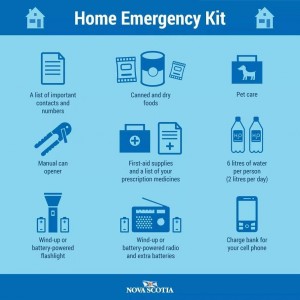**** NSP Media Release
BEFORE THE STORM – PREPARATION IS KEY
We know that Nova Scotians rely on electricity to go about their daily lives. Being prepared can help you stay calm, and just know that our crews are working safely and quickly to restore your power.
- Add our outage line 1-877-428-6004 to the list of emergency phone numbers near your phone, or bookmark our outage map and online outage reporting tool.
- Track bad weather by following local weather reports or by visiting Environment Canada online.
- Have an emergency kit with flashlights, a battery-operated radio and fresh water. Download the Red Cross Emergency Preparedness Checklist.
- To avoid electrical surges if you do lose power, turn off and unplug electrical equipment such as televisions.
- Learn to manually operate your automatic garage door.
- Make sure backup generators are installed by a qualified electrician and follow the manufacturer’s safety instructions.
Generator safety: installation
Generators that aren’t installed correctly put you, your family, your property and our line crews at risk.
Never install a generator indoors. If you plan to connect your generator directly to your electrical system, a qualified electrician must install it. The electrician must apply for a wiring permit and have the generator inspected by a Nova Scotia Power wiring inspector before it is used.
Never feed power from your generator into a wall outlet or directly into your electrical system. This could allow power to back-feed into our system and result in severe injury or death to our employees. When power is restored after and outage, it may feed directly into your generator, causing severe damage. To eliminate this dangerous situation, a transfer switch is required to be properly installed by a qualified electrician.
DURING THE STORM – STAY CLEAR FROM HAZARDOUS SITUATIONS
For safety, consider all cables and wires to be energized whether they are electrical, cable or telephone and stay a school bus distance away. If a line is in the water, there is even more reason to be cautious and consider it and the water energized. Keep children away from all flooded areas and areas with lots of debris because the water or storm debris could be hiding an energized line.
You shouldn’t try to remove or trim branches near a power line. If a tree or tree limbs have fallen on a power line or pulled it down, keep a safe distance from the line or the tree. Contact us as soon as you can at 1-877-428-6004.
Step Potential Hazard
When an energized line makes contact with the ground, the earth becomes energized. The voltage dissipates in circles away from the initial contact point. Never walk or run from a downed power line – hop or shuffle to safety.
Generator safety: Safe operation
To ensure you are using your generator safely:
- Carefully read the owner’s manual before using your generator.
- Never operate the generator indoors or in an enclosed space. Generators emit deadly carbon monoxide fumes. Operate outdoors in a well-ventilated, dry area to prevent exhaust fumes from entering windows, doors and fresh air intake areas.
- Operating your generator in wet conditions may cause electrocution. Avoid contact with the generator if you are wet or standing in water.
- Check cords running from your generator to make sure they are in good condition, rated for outdoor use and are the proper wire gauge size for the appliance load.
- Do not store fuel indoors or refuel your generator while it’s running.
Carbon monoxide can kill
- Carbon monoxide is a gas you cannot see or smell created by the combustion of fuels, such as gasoline, wood, coal, natural gas, propane, oil, and methane.
- Every year, dozens of Nova Scotians are admitted to hospital with carbon monoxide poisoning, and in some cases the poisoning is fatal. Symptoms of carbon monoxide poisoning can include headache, nausea, dizziness, and blurred vision.
- There are many common sources of carbon monoxide, including vehicles, furnaces and blocked chimneys. Generators can also be a source, so it is essential that generators are installed properly, outside, and away from any potential point of entry that would allow fumes into your home or business.
- All homes should have a carbon monoxide detector, particularly if you have a furnace, woodstove, generator, or garage. Carbon monoxide detectors are sold at most hardware and home supply stores.
For more information on carbon monoxide, the proper installation and use of detectors, and safety tips, please visit 811 Nova Scotia and the Halifax Professional Firefighters Association.
Water and Electricity Do Not Mix
Don’t attempt to access your electrical panel if there is water in the immediate area. Customers should take every precaution and never come into contact with the water or the panel until power has been disconnected.
Customers should contact our Customer Care Centre at 1-877-428-6004 and request an emergency disconnect of power. Before service can be restored, a certified electrician will need to facilitate the necessary repairs and inspection.
AFTER THE STORM – ASSESS YOUR PROPERTY AND REPLENISH SUPPLIES
Storms can cause electrical damage to individual properties that require a certified electrician to repair before we can safely restore the power to your home or business. If your meter mast is damaged, you need to get an electrical contractor to make repairs before we can restore power. Ensure you refill your supplies to be ready the next storm a storm hits. Read more on our Meter Mast Repair page.
When the storm passes, make sure to replenish your emergency kit and any other required items to ensure you’re prepared next time.




